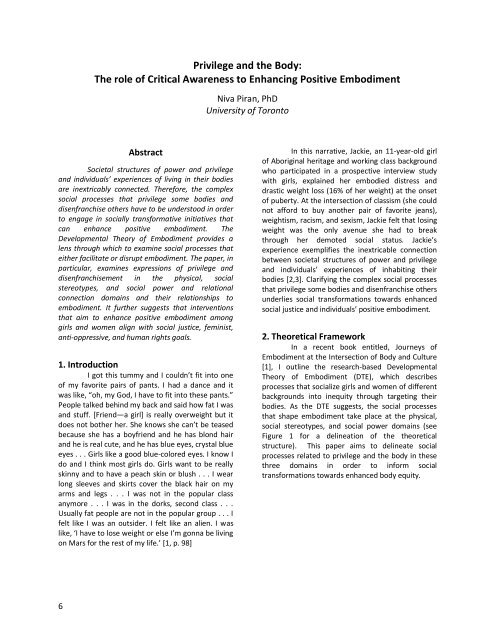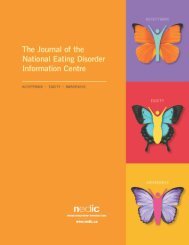NEDIC Conference Journal 2018
Create successful ePaper yourself
Turn your PDF publications into a flip-book with our unique Google optimized e-Paper software.
Privilege and the Body:<br />
The role of Critical Awareness to Enhancing Positive Embodiment<br />
Niva Piran, PhD<br />
University of Toronto<br />
Abstract<br />
Societal structures of power and privilege<br />
and individuals’ experiences of living in their bodies<br />
are inextricably connected. Therefore, the complex<br />
social processes that privilege some bodies and<br />
disenfranchise others have to be understood in order<br />
to engage in socially transformative initiatives that<br />
can enhance positive embodiment. The<br />
Developmental Theory of Embodiment provides a<br />
lens through which to examine social processes that<br />
either facilitate or disrupt embodiment. The paper, in<br />
particular, examines expressions of privilege and<br />
disenfranchisement in the physical, social<br />
stereotypes, and social power and relational<br />
connection domains and their relationships to<br />
embodiment. It further suggests that interventions<br />
that aim to enhance positive embodiment among<br />
girls and women align with social justice, feminist,<br />
anti-oppressive, and human rights goals.<br />
1. Introduction<br />
I got this tummy and I couldn’t fit into one<br />
of my favorite pairs of pants. I had a dance and it<br />
was like, “oh, my God, I have to fit into these pants.”<br />
People talked behind my back and said how fat I was<br />
and stuff. [Friend—a girl] is really overweight but it<br />
does not bother her. She knows she can’t be teased<br />
because she has a boyfriend and he has blond hair<br />
and he is real cute, and he has blue eyes, crystal blue<br />
eyes . . . Girls like a good blue-colored eyes. I know I<br />
do and I think most girls do. Girls want to be really<br />
skinny and to have a peach skin or blush . . . I wear<br />
long sleeves and skirts cover the black hair on my<br />
arms and legs . . . I was not in the popular class<br />
anymore . . . I was in the dorks, second class . . .<br />
Usually fat people are not in the popular group . . . I<br />
felt like I was an outsider. I felt like an alien. I was<br />
like, ‘I have to lose weight or else I’m gonna be living<br />
on Mars for the rest of my life.’ [1, p. 98]<br />
In this narrative, Jackie, an 11-year-old girl<br />
of Aboriginal heritage and working class background<br />
who participated in a prospective interview study<br />
with girls, explained her embodied distress and<br />
drastic weight loss (16% of her weight) at the onset<br />
of puberty. At the intersection of classism (she could<br />
not afford to buy another pair of favorite jeans),<br />
weightism, racism, and sexism, Jackie felt that losing<br />
weight was the only avenue she had to break<br />
through her demoted social status. Jackie’s<br />
experience exemplifies the inextricable connection<br />
between societal structures of power and privilege<br />
and individuals’ experiences of inhabiting their<br />
bodies [2,3]. Clarifying the complex social processes<br />
that privilege some bodies and disenfranchise others<br />
underlies social transformations towards enhanced<br />
social justice and individuals’ positive embodiment.<br />
2. Theoretical Framework<br />
In a recent book entitled, Journeys of<br />
Embodiment at the Intersection of Body and Culture<br />
[1], I outline the research-based Developmental<br />
Theory of Embodiment (DTE), which describes<br />
processes that socialize girls and women of different<br />
backgrounds into inequity through targeting their<br />
bodies. As the DTE suggests, the social processes<br />
that shape embodiment take place at the physical,<br />
social stereotypes, and social power domains (see<br />
Figure 1 for a delineation of the theoretical<br />
structure). This paper aims to delineate social<br />
processes related to privilege and the body in these<br />
three domains in order to inform social<br />
transformations towards enhanced body equity.<br />
6




